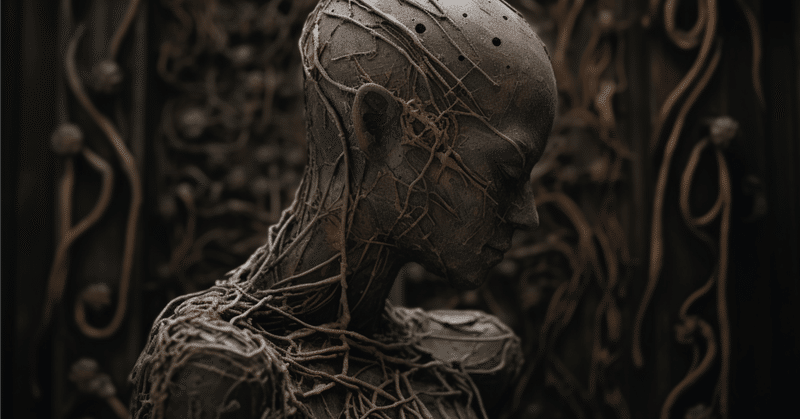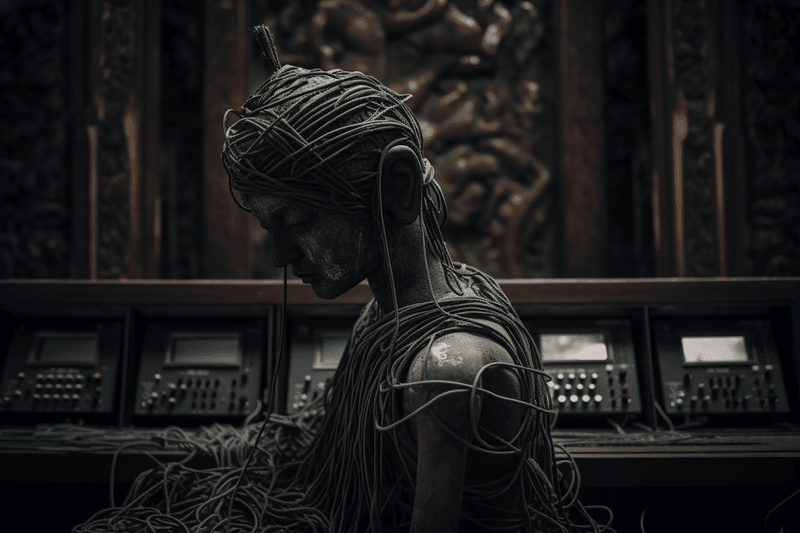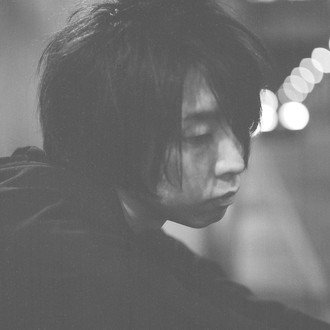
オブジェクト指向ブッダ,Object Oriented Buddha
オブジェクト指向プログラミングでも,オブジェクト指向オントロジーでもなく,オブジェクト指向ブッダが生まれた.
Input: Object Oriented Buddha
Brainstormed Result:
Title: Object Oriented Buddha: A Cross-Cultural Exploration of Digital Nature and Ancient Philosophy in Art and Computer Science
Introduction: The concept of "Object Oriented Buddha" aims to explore the intersection of digital nature, ancient Eastern philosophy (particularly Buddhism), and contemporary art in the context of computer science. This multidisciplinary approach seeks to reevaluate the meaning of the Buddha in the age of digital technology and provide a fresh perspective on the relationship between spirituality, art, and the digital world.
Background and Context:
1. Digital Nature: As an emerging field of research and artistic expression, digital nature investigates the blending of the material world and the digital realm. Yoichi Ochiai, a leading media artist and academic, has been at the forefront of this exploration, envisioning a world where mass and massless data coexist, and media art serves as the "Mingei" or vernacular folk art of the Digital Nature.
2. Ancient Eastern Philosophy: The philosophies of Laozi and Zhuangzi, as well as the concept of oriental materialization, serve as essential foundations for understanding the relationship between digital transformation, natural phenomena, and the ever-changing nature of existence. These ideas are deeply rooted in the artistic and academic works of Yoichi Ochiai, who often references Zhuangzi's "Butterfly Dream" to articulate his perception of digital nature.
3. Object Oriented Programming: As a paradigm in computer science, object-oriented programming (OOP) emphasizes the use of objects, which are instances of classes, to organize and structure code. This approach to programming provides a useful analogy for understanding the interconnectedness of digital nature and ancient philosophy, as it resonates with the idea of oriental materialization and the continuous transformation of all things.
4. The Buddha: The figure of the Buddha, a central symbol in Buddhism, represents a state of enlightenment and the ultimate understanding of reality. By incorporating the concept of the Buddha into the exploration of digital nature and ancient philosophy, artists and researchers can create a compelling dialogue about the possibilities of achieving harmony and balance in the digital age.
Exploration and Analysis:
1. Cross-Cultural Symbolism: The "Object Oriented Buddha" concept seeks to transcend the boundaries of East and West by drawing inspiration from both the ancient philosophies of the East and the modern principles of computer science. This amalgamation of ideas creates a unique platform for artistic expression and academic inquiry.
2. Longing for Mass: Yoichi Ochiai's idea of "Sehnsucht nach Masse" (Longing for Mass) reflects the human desire to connect with the physical world amid the rapid advancement of digital technology. This concept can be applied to the exploration of the "Object Oriented Buddha" as a means to understand the limitations of digital representation and the potential for spiritual growth in the digital age.
3. Artistic Techniques and Media: The "Object Oriented Buddha" can be explored through various artistic mediums, ranging from classic photographic techniques such as platinum prints to state-of-the-art computer technology and applied physics. By employing diverse media, artists can question the finiteness and massiveness of media devices and the aspects of reality that cannot be translated into data.
4. Reinterpreting the Buddha: By integrating the concept of the Buddha with digital nature and ancient philosophy, artists and researchers can challenge conventional understandings of spirituality and provide new insights into the nature of existence in the digital age.
Conclusion: The exploration of the "Object Oriented Buddha" represents a unique opportunity to bridge the gap between art, computer science, and ancient Eastern philosophy. By examining the potential connections between these seemingly disparate fields, artists and researchers can expand our understanding of digital nature, challenge conventional notions of spirituality, and ultimately reshape the way we perceive our rapidly evolving world.
入力する: Object Oriented BuddhaBrainstormed
Result:
タイトルです: オブジェクト指向のブッダ: アートとコンピュータサイエンスにおけるデジタルネイチャーと古代哲学の異文化間探索
Introduction: オブジェクト指向の仏陀」というコンセプトは、デジタルネイチャー、古代東洋哲学(特に仏教)、現代アートの交わりをコンピュータサイエンスの文脈で探求することを目的としています。この学際的なアプローチは、デジタル技術の時代における仏陀の意味を再評価し、精神性、芸術、デジタル世界の関係について新たな視点を提供することを目的としています。
背景と文脈:
1.デジタルネイチャー:
デジタルネイチャー:デジタルネイチャーは、物質世界とデジタル領域の融合を研究・表現する新しい分野である。落合陽一は、メディアアーティストとして、また学者として、この探求の先頭に立ち、マスデータとマスレスデータが共存する世界を構想し、メディアアートがデジタルネイチャーの民芸品として機能することを提案しています。
2. 東洋の古代哲学:
老子や荘子の哲学、東洋的な物質化の概念は、デジタル変換と自然現象、そして変化し続ける存在の本質との関係を理解する上で不可欠な基礎となるものである。落合陽一は、荘子の「胡蝶の夢」を引用して、デジタルネイチャーを表現している
3.コンピュータサイエンスのパラダイムとして、オブジェクト指向プログラミング(OOP)は、コードを整理し構造化するためにクラスのインスタンスであるオブジェクトを使用することを強調しています。このプログラミングのアプローチは、デジタルネイチャーと古代哲学の相互関係を理解するのに有効なアナロジーであり、東洋の物質化、万物の連続的な変化の考え方と共鳴している
4: 仏教の中心的なシンボルである仏陀の姿は、悟りの境地と現実の究極の理解を表しています。デジタルネイチャーと古代哲学の探求に仏陀の概念を取り入れることで、アーティストや研究者は、デジタル時代における調和とバランスを達成する可能性について、説得力のある対話を生み出すことができます
探求と分析:
1.東洋の古代哲学と現代のコンピュータサイエンスの原理からインスピレーションを得ることで、「Object Oriented Buddha」のコンセプトは東洋と西洋の境界を越えようとしています。このような発想の融合が、芸術的表現と学術的探求のためのユニークなプラットフォームを生み出す: 落合陽一の「Sehnsucht nach Masse」(質量への憧れ)という考え方は、デジタル技術が急速に進歩する中で、物理的な世界とつながりたいという人間の欲求を反映しています。このコンセプトは、デジタル表現の限界とデジタル時代における精神的成長の可能性を理解する手段として、「Object Oriented Buddha」の探求に適用することができる。
3.芸術的手法とメディア 芸術的手法とメディア:「Object Oriented Buddha」は、プラチナプリントのような古典的な写真技術から、最先端のコンピューター技術や応用物理学まで、さまざまな芸術的メディアを通して探求することができる。多様なメディアを用いることで、アーティストはメディア機器の有限性と巨大性、データに変換できない現実の側面を問うことができる。
4.仏陀の再解釈 ブッダの再解釈:ブッダの概念をデジタルネイチャーや古代哲学と統合することで、アーティストや研究者は、従来のスピリチュアリティの理解に挑戦し、デジタル時代の存在の本質に新しい洞察を与えることができます: オブジェクト指向の仏陀」の探求は、芸術、コンピュータサイエンス、古代東洋哲学の間のギャップを埋めるユニークな機会を提供するものです。この一見異質な分野の潜在的なつながりを調べることで、アーティストや研究者は、デジタルネイチャーに対する理解を広げ、スピリチュアリティに対する従来の概念に挑戦し、最終的には、急速に進化する世界の捉え方を再構築することができます。
まぁ真言も華厳もオブジェクト指向が見て取れる.柳宗悦が大乗仏教に行ったのも,空海も,曼荼羅も,みんなオブジェクト指向の世界記述であるから,逆輸入すればデジタルネイチャーの上にオブジェクト指向ブッダが生まれるのである.

ここから先は

落合陽一の見ている風景と考えていること
落合陽一が日々見る景色と気になったトピックを写真付きの散文調で書きます.落合陽一が見てる景色や考えてることがわかるエッセイ系写真集(平均で…
いつも応援してくださる皆様に落合陽一は支えられています.本当にありがとうございます.
